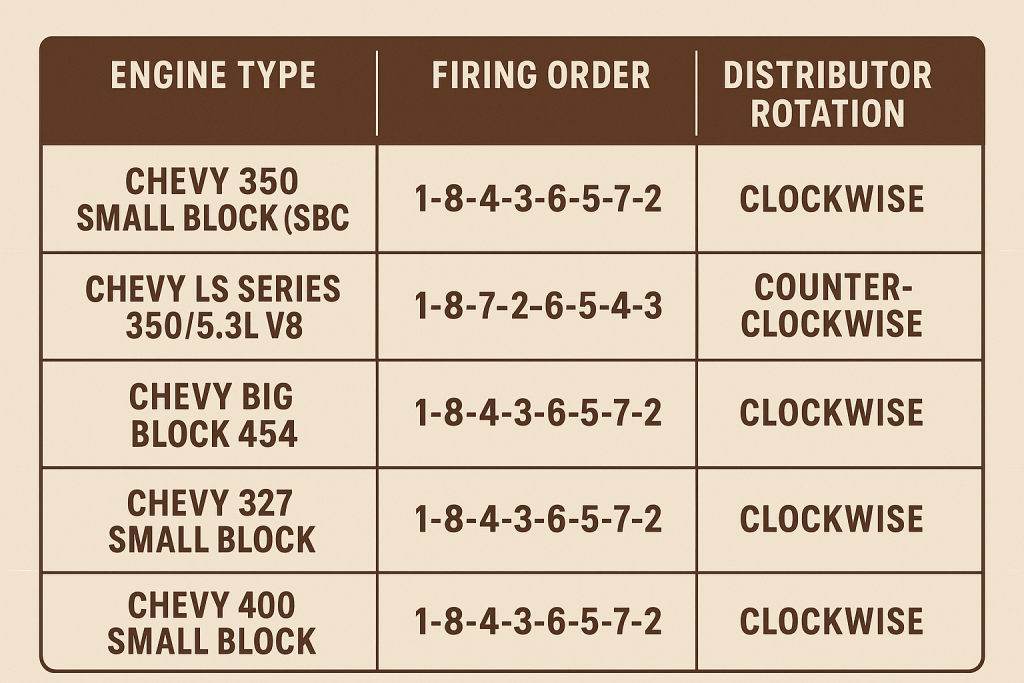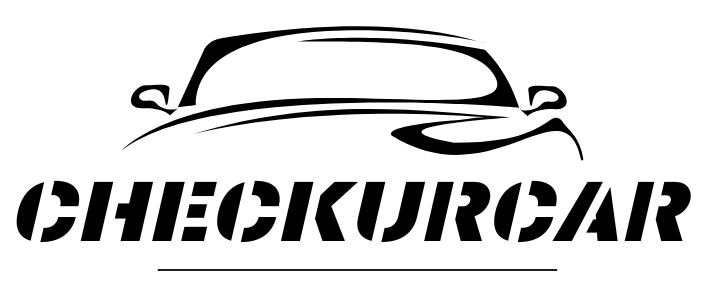The Chevy 350 engine is one of the most popular and trusted V8 engines ever built. But to keep it running smoothly, knowing its correct firing order is key. If your engine misfires or feels rough, the firing order diagram can help you fix it fast. In this guide, we’ll break down the Chevy 350 firing order diagram, explain how the spark plug wires connect, and help you understand each cylinder’s position in simple terms. Let’s make your engine run perfectly again.
What Is a Firing Order?
A firing order is the specific sequence in which an engine’s cylinders ignite the spark plugs to burn fuel and produce power. It ensures the engine runs smoothly, balances power delivery, and prevents vibrations by timing the sparks in the right order for efficient combustion.
Chevy 350 Firing Order Explained
The firing order of a Chevy 350 engine is the sequence in which the spark plugs fire in the cylinders. For the Chevy 350, this order is 1-8-4-3-6-5-7-2. This means cylinder number one fires first, followed by cylinder eight, then four, and so on, in that exact pattern. The firing order is important because it controls the timing of the spark that ignites the fuel-air mixture inside the engine.
Why Firing Order Matters
The correct firing order helps the engine run smoothly, provides balanced power delivery, and prevents engine vibrations. The Chevy 350 has a distributor that rotates clockwise to send the spark to each cylinder in the right timing. The cylinders are arranged in a V8 layout, with odd-numbered cylinders on the driver’s side (1, 3, 5, 7) and even-numbered cylinders on the passenger side (2, 4, 6, 8).
Problems From Incorrect Firing Order
If the firing order is wrong, the engine may misfire, run roughly, or fail to start properly. Misfires cause loss of power and can damage engine components over time. By following the proper firing order and wiring the spark plug wires correctly to the distributor, you ensure your Chevy 350 performs reliably and efficiently.
Chevy 350 Firing Order Diagram
The Chevy 350 firing order is the sequence in which the engine’s cylinders fire to keep it running smoothly. For the Chevy 350, the firing order is 1-8-4-3-6-5-7-2. This means cylinder number 1 fires first, then 8, then 4, and so on.
Cylinder Layout
The Chevy 350 is a V8 engine with two banks of cylinders:
- Driver’s side (Bank 1): Cylinders 1, 3, 5, 7
- Passenger’s side (Bank 2): Cylinders 2, 4, 6, 8
Distributor and Spark Plug Wiring
The distributor rotates clockwise. The #1 spark plug wire connects to the terminal on the distributor where the rotor points at the top dead center of cylinder 1. Following the firing order, each spark plug wire connects to the next terminal in this order: 1, 8, 4, 3, 6, 5, 7, 2.

Step-by-Step Guide to Wiring Spark Plugs on a Chevy 350
Wiring the spark plugs correctly in a Chevy 350 is important for the engine to run smoothly. Follow these simple steps to wire your spark plugs in the right firing order.
Step 1: Know the Firing Order and Distributor Rotation
The firing order for the Chevy 350 is 1-8-4-3-6-5-7-2. The distributor rotates clockwise. Make sure you understand this before starting.
Step 2: Identify Cylinder #1
Locate cylinder #1 on the engine. It is usually the front cylinder on the driver’s side (left bank). Identify the corresponding terminal on the distributor where the rotor points when the engine is at top dead center for cylinder #1.
Step 3: Connect the #1 Spark Plug Wire
Attach the spark plug wire for cylinder #1 to the distributor terminal you identified. Then run the wire to cylinder #1 and connect it securely to the spark plug.
Step 4: Follow the Firing Order Clockwise Around the Distributor
Moving clockwise on the distributor cap, connect the wires according to the firing order:
- #1 to cylinder 1
- #8 to cylinder 8
- #4 to cylinder 4
- #3 to cylinder 3
- #6 to cylinder 6
- #5 to cylinder 5
- #7 to cylinder 7
- #2 to cylinder 2
Step 5: Check Wire Lengths and Routing
Use the longer wires for cylinders further from the distributor. Arrange wires neatly and avoid crossing or tangling to prevent misfires.
Step 6: Secure All Connections
Ensure all wires are firmly connected at both the distributor and spark plugs. Loose connections can cause engine misfires.
Step 7: Test the Engine
Start the engine to confirm it runs smoothly. If it misfires or runs rough, double-check the firing order and wiring connections.
Variations and Related Engine Firing Orders
Firing orders are the sequence engines use to ignite cylinders for smooth running. Different Chevy engines have varied firing orders based on design and performance needs. Understanding these differences helps with proper maintenance and tuning.

Common Problems From Incorrect Firing Order
An incorrect firing order can cause several engine issues that affect performance and reliability. Here are common problems to watch for:
- Engine Misfires: The engine may run rough or shake because cylinders fire at the wrong time.
- Hard Starting: The engine may struggle or fail to start due to improper ignition timing.
- Loss of Power: Wrong firing sequence reduces engine efficiency and power output.
- Rough Idle: The engine may idle unevenly or stall unexpectedly.
- Backfiring: Fuel can ignite at the wrong time, causing loud pops or backfires.
- Increased Engine Wear: Continuous firing order errors can damage engine parts over time.
If you notice any of these symptoms, check the firing order and spark plug wiring first. Incorrect wiring is a common cause and is easy to fix, preventing costly repairs and keeping your Chevy 350 running smoothly.
Chevy 350 Maintenance Tips Related to Ignition
The ignition system is an essential part of the Chevy 350 engine. It creates and delivers the spark needed to ignite the fuel-air mixture in the cylinders. Proper maintenance of the ignition system ensures smooth engine performance, better fuel economy, and longer engine life.
Regular Inspection
Check your ignition system components regularly, including spark plugs, wires, distributor cap, and rotor. Look for signs of wear, corrosion, or damage. Replacing worn parts prevents misfires and engine problems.
Spark Plug Care
Change spark plugs at recommended intervals, typically every 30,000 to 100,000 miles. Keep spark plugs clean and free of deposits for good spark and combustion.
Proper Wiring
Ensure all ignition wires are connected correctly following the firing order (1-8-4-3-6-5-7-2). Secure connections prevent misfires. Use high-quality wires and keep cables organized to avoid tangling.
Distributor Maintenance
Set the distributor’s rotor to the #1 cylinder at top dead center (TDC) compression stroke before starting. Check and replace the distributor cap and rotor as needed to maintain a strong spark.
Battery and Coil Checks
Keep the battery terminals clean and tight. Inspect the ignition coil for damage and replace if it shows signs of wear or cracking. A strong coil provides a reliable spark.
Timing Adjustment
Regularly verify ignition timing using a timing light. Correct timing (usually 0-4° BTDC for stock setups) improves performance and fuel efficiency.
Conclusion
Knowing the Chevy 350 firing order is essential to keep your engine running right. It helps your cylinders fire in the correct sequence, preventing misfires, shaking, or power loss. Always double-check your firing order when replacing spark plug wires or tuning the engine to avoid costly mistakes.
A small step like this can make a big difference in engine performance. Take a moment today to check your engine setup and follow the proper firing order for a smoother, stronger, and more reliable Chevy 350 experience.
FAQs
Can I change the firing order on a Chevy 350?
No, the firing order is set by the camshaft design and cannot be changed.
Is the Chevy 350 firing order the same as other Chevy V8s?
Yes, most small-block Chevy V8s share the same 1-8-4-3-6-5-7-2 firing order.
How do I find cylinder 1 at top dead center (TDC)?
Rotate the crankshaft until the timing mark aligns and cylinder 1’s piston is at the top of its stroke.
Can a wrong spark plug wire connection cause damage?
Yes, it can lead to backfiring or engine misfires.
What tool can I use to check spark plug firing?
You can use a spark tester or timing light.


